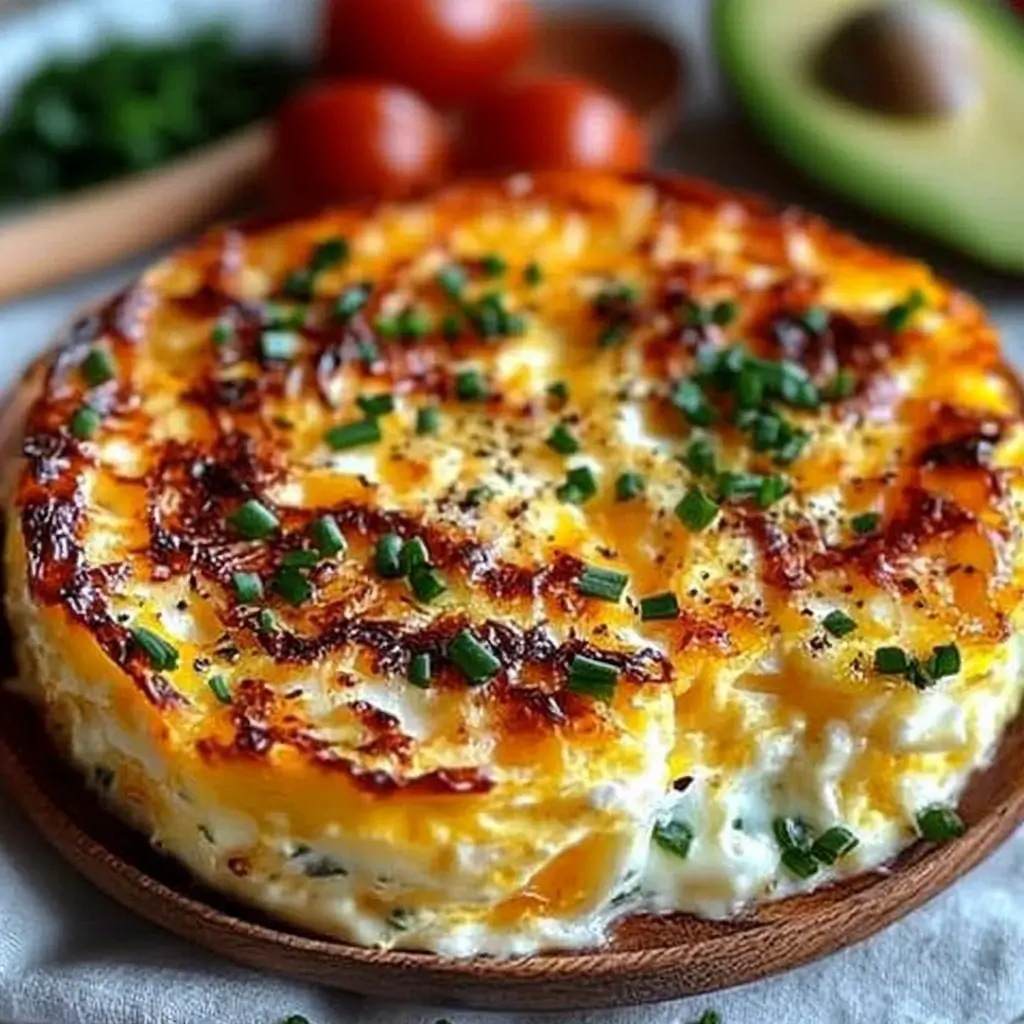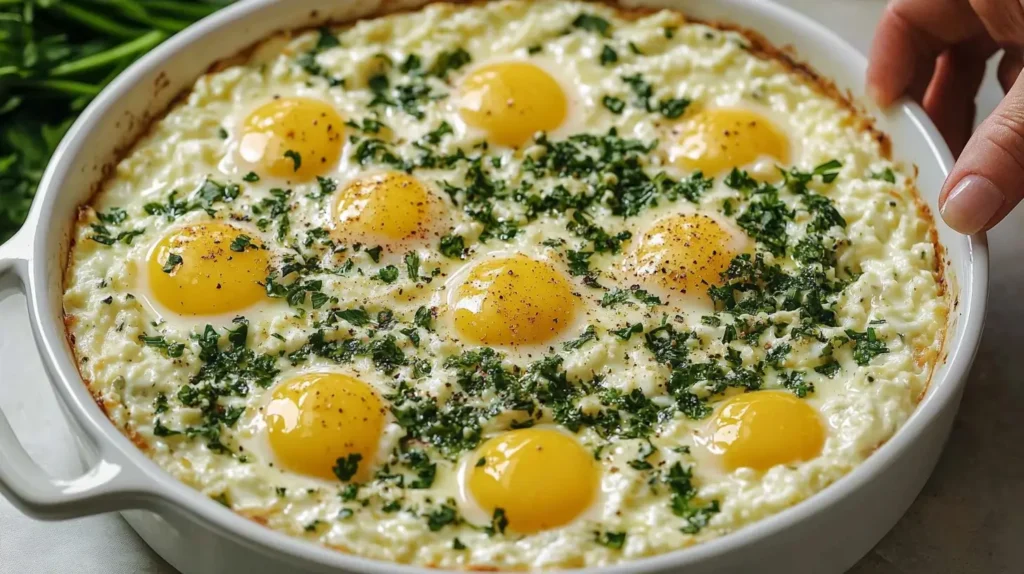Difficulty
Easy
Prep time
10 minutes
Cooking time
20 minutes
Total time
30 minutes
Servings
4 servings
Experience the perfect blend of creamy, protein-rich comfort with these Baked Cottage Cheese Eggs. This innovative breakfast dish transforms simple ingredients into a satisfying meal that’s as nutritious as it is delicious. The cottage cheese creates a fluffy, creamy base while the eggs bake to perfection on top, yielding golden yolks nestled in a savory bed of herbs and cheese. With minimal prep work and hands-off baking time, this recipe is ideal for busy mornings, meal prep, or a leisurely weekend brunch. High in protein and low in carbs, these baked eggs offer a filling start to your day without weighing you down. Whether you’re following a specific eating plan or simply seeking a wholesome breakfast option, this versatile dish will quickly become a staple in your morning rotation!
Ingredients
2 cups cottage cheese (4% or 2% milkfat)
4 large eggs
2 tablespoons grated Parmesan cheese
2 tablespoons chopped fresh chives (plus more for garnish)
1 tablespoon chopped fresh dill (or 1 teaspoon dried)
1/2 teaspoon garlic powder
1/4 teaspoon onion powder
1/4 teaspoon smoked paprika (plus more for garnish)
Salt and freshly ground black pepper to taste
2 tablespoons olive oil or butter
Optional toppings: sliced avocado, cherry tomatoes, microgreens, everything bagel seasoning, hot sauce
Execution
Preheat the Oven: Set your oven to 375°F (190°C) and allow it to fully preheat.
Prepare the Baking Dish: Brush the inside of a 9-inch baking dish or four individual ramekins with olive oil or butter to prevent sticking.
Mix the Cottage Cheese Base: In a medium bowl, combine the cottage cheese, Parmesan cheese, chopped chives, dill, garlic powder, onion powder, smoked paprika, salt, and pepper. Stir until well combined.
Transfer to Baking Dish: Spread the cottage cheese mixture evenly in the prepared baking dish. If using individual ramekins, divide the mixture equally among them.
Create Wells for the Eggs: Using the back of a spoon, make four indentations in the cottage cheese mixture, spaced evenly apart. These will cradle the eggs.
Add the Eggs: Carefully crack an egg into each indentation, keeping the yolks intact.
Season the Eggs: Lightly sprinkle each egg with a pinch of salt, pepper, and smoked paprika.
Bake: Place the baking dish in the preheated oven and bake for 15-20 minutes. For runny yolks, aim for about 15 minutes; for firmer yolks, extend the baking time to 20 minutes.
Check for Doneness: The dish is ready when the egg whites are set but the yolks are still slightly jiggly (unless you prefer fully set yolks). The cottage cheese should be heated through and beginning to turn golden around the edges.
Serve: Remove from the oven and let stand for 2-3 minutes. Garnish with additional fresh chives, a sprinkle of smoked paprika, and any optional toppings. Serve warm.
Additional tips
- Texture Preference: If you prefer a smoother base, pulse the cottage cheese in a food processor before mixing with the herbs and spices.
- Flavor Variations: Try Mediterranean-style with sundried tomatoes and olives mixed into the cottage cheese, or Southwest-style with diced green chilies and a sprinkle of cumin.
- Make Ahead Option: Prepare the cottage cheese mixture up to 24 hours ahead and refrigerate. Add 2-3 minutes to the baking time if starting with a cold base.
- Protein Boost: Mix in 2 tablespoons of hemp seeds or chopped cooked bacon to the cottage cheese mixture for extra protein.
- Lower Fat Alternative: Use 1% or fat-free cottage cheese and reduce the Parmesan to 1 tablespoon.
- Vegetable Add-ins: Fold 1/2 cup of sautéed spinach, mushrooms, or bell peppers into the cottage cheese mixture before baking.
- Serving Suggestion: Pair with sliced avocado and whole grain toast for a complete breakfast, or serve with a simple green salad for lunch.
- Dairy-Free Option: While it changes the dish significantly, you can substitute the cottage cheese with silken tofu blended with 1 tablespoon of nutritional yeast for a dairy-free alternative.
FAQ
1. Can I use cottage cheese with different fat percentages?
Yes! While 4% (full-fat) cottage cheese yields the creamiest result, 2% or even 1% works well for a lighter option. The lower the fat content, the slightly less creamy the final dish will be.
2. How can I tell when the eggs are perfectly cooked?
The whites should be completely set with no transparency, while the yolks can range from runny to fully set based on preference. For runny yolks, look for a slight jiggle when you gently shake the dish. For fully set yolks, the entire egg should be firm to the touch.
3. Can I make this dish for meal prep?
Yes! Bake as directed, allow to cool completely, then refrigerate in airtight containers for up to 3 days. Reheat gently in the microwave at 50% power or in a 300°F oven until just warm. Note that the yolks will continue to cook when reheated.
4. Is this recipe keto-friendly?
Yes, this dish is naturally low in carbohydrates and high in protein and healthy fats, making it suitable for ketogenic diets.
5. Can I freeze leftovers?
This dish doesn’t freeze well as the texture of both the eggs and cottage cheese can become watery and grainy when thawed.
6. What herbs can I substitute if I don’t have chives or dill?
Fresh basil, thyme, oregano, or parsley all work well as substitutes. For dried herbs, use about 1/3 the amount called for in the fresh herb measurements.
7. Can I add meat to this recipe?
Absolutely! Mix in 1/4 cup of cooked and crumbled bacon, diced ham, or cooked sausage to the cottage cheese mixture before baking.
8. Is there a broiling step needed?
While not necessary, you can finish the dish under the broiler for 1-2 minutes if you prefer a more golden top with slightly crispy edges.


